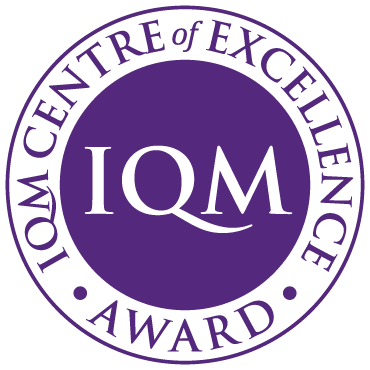Reading Strategy
Reading is at the heart of all we do at Lambs Lane. We believe reading is one of the best tools we can give to our children in order to shape them into independent, imaginative and life-long learners.
We teach reading, both explicitly, and through our wider curriculum; and we ask our parents/carers to support/partner us in this through reading specifically chosen material with their children at least 5 days in every week.
Synthetics and Systematic Phonics scheme used: Read Write Inc.
Read-Write Inc mission statement- Ruth Miskin Training:
Read Write Inc. programmes work because we get children’s brain ‘COGS’ working.
Everything CONNECTS: children connect sounds with mnemonic pictures; words with their meanings; and stories with the sounds they know. They connect their own experiences to the stories they read and learn to lift the words off the page.
Children learn ONE thing at a time and practise it until it becomes second nature. Interactive practice keeps children focused, and their capacity to learn develops exponentially.
They learn at their GOLDILOCKS spot (not too easy, not too hard) with others at a similar challenge level. No time is wasted.
Children remember what they learn by SAYING it out loud to a partner. If they can’t explain it, the teacher repeats it until they can.
What’s more, our teachers are trained so they have capacity to show love for what they do. The more they love teaching, the more the children love learning.
Our Phonic Strategy:
- All children in EYFS and Year 1 enrolled as a matter of course. Additional children from upper years enrolled alongside where their learning needs still sit within a phonic programme.
- Children take place in 4x full RWI lessons each week
- Phonic sessions start in EYFS where sounds learning builds up to allow a reading and writing programme to begin and work alongside.
- Sessions in Year 1 onwards comprise of three sections: sounds, reading and Get Writing
- Children are assessed half-termly and grouped accordingly
- Sessions are rigorous, snappy and successful for all
- All children take home books to coincide directly with their level of phonic knowledge
- Children who show a need for additional support are tutored 1:1 during the afternoon sessions. This helps to ensure all children keep up, and don’t have to catch up.
In year 2, when children have worked all the way through the RWI scheme and have a secure phonic understanding, they join the class to be part of a Book Talk session. This is a way of teaching reading which is based around Jane Considine’s approach.
‘Book Talk’ is a systematic way to teach reading strategies across the whole school from Year 1 to Year 6. We use this in year 2 as an effective way to grow ‘thinking readers’. It is underpinned by certain guiding principles, these are outlined below:
- Pupils are organised into reading attainment groups and share a set of the ‘same’ books pitched at their level with appropriate challenge.
- All pupils in the classroom will be accessing narrative, non-fiction or poetry at the same time.
- Pupils will receive a daily 20-30 minute ‘Book Talk’ session and once a week will intensively work with the class teacher for a ‘guided read’
- The session is layered with open-ended whole class questions to tackle different aspects of the curriculum.
- A hallmark of the session is on developing reading for meaning and oral comprehension techniques.
- Book Talk is structured with reasons to read.
- The sessions work best if they operate like conversations about books and ‘hands up’ is not used so there is a natural flow of talk about what they are reading.
- During these sessions the pleasure principle of reading is fostered and highly engaging picture books should be used in favour of phonic based books to heighten engagement and excitement.
- ‘Book Talk’ is sharply focused on reading for meaning, listening to friends read and talking about books.
- During these sessions pupils could be ‘reading around the group’, reading in pairs or reading to themselves and the teacher will direct them in these different organisational ways
In order to ensure this method of reading teaching fits in with the teaching we do in the rest of the school, our year 2 book talk sessions have an added level - which is an identification of the reading skill the children are working on with each question. Across the whole school, we identify reading skills by using the Literacy Shed acronym, VIPERS:
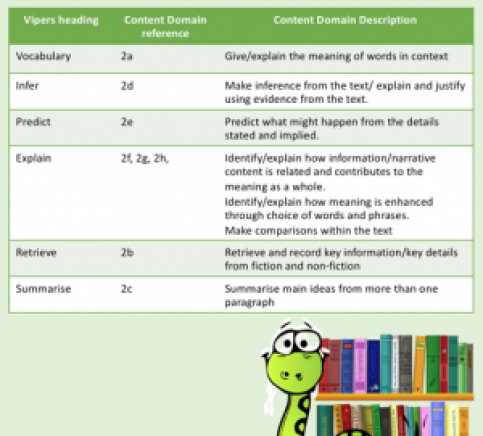
In year 3 and 4, we build on the methods used in year 2 by using a combination of Book Talk and specific comprehension skills teaching. We decided to combine these methods as we felt our children’s independent comprehension skills required improvement. By combining them, children get the best of the Book Talk approach (including access to high quality ability-suitable books) and specifically develop each of their VIPERS comprehension skills. Within all of these sessions, teachers and TAs split their time according to need in the classroom. The lowest 20% of readers are of the highest priority. Within all of these sessions, there is also an increased emphasis on the children being able to first orally rehearse, then write their thinking down.
In both year 3 and 4, three days are spent on Book Talk in ability groups, and one is spent on comprehension.
Some of the materials used to aid specific comprehension skills teaching include those in the schemes below. The ‘Classics: A Voyage of Discovery’ series allow us to extend some cultural capital into our reading sessions too:

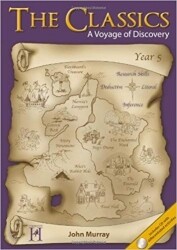
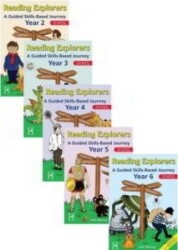
In upper key stage 2, we continue to build on the foundations of reading that have been laid lower down the school.
In these year groups, we employ a Book Talk style approach to whole class guided reading for some of our teaching weeks: this approach allows every child in the class to access texts they may not be able to access independently. It also allows our children to work collaboratively with others, learning from their peers about how to best structure their book-related thinking and answers. In other teaching weeks, we use the materials above (as well as a number of others) to further improve the children’s comprehension skills- the planning of this is based on our on-going assessment of their needs.
We expect all children to read at home 5x each week. These reads are noted in children’s reading records. In each class, staff monitor the reading that has happened and employ age-appropriate techniques to help children who struggle to read as often as they should. SLT members monitor this and work with families to improve parental engagement in children’s reading.
Which books do children take home from school?
KS1
- If a child is engaged in the RWI system, they will be provided with a phonics-appropriate book to come home with and practice reading independently
- Once children finish the RWI system, they begin to bring colour-banded books home with them- these too are closely matched to the child’s reading ability and should be independently decodable
- Children in KS1 also get a choice of a non-phonics matched book- these are the picture and non-fiction books of the school that are greatly enjoyable and match our children’s interests. These books are marked with a special sticker (see below), and parents receive information about their role as books for sharing and enjoyment (separate form their child’s phonics journey)
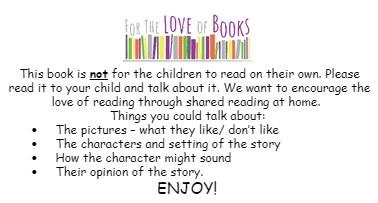
KS2
- For children still enrolled in RWI system, a RWI phonics-matched book will be provided
- All other children are assessed once each long term under the Accelerated Reader Star Test system, this provides them with a current and effective ZPD (Zone of Proximal Development) from which they can select a book which is within their comprehending/vocabulary range. The children are then quizzed on these books once they finish them
- Staff in KS2 use the data from Star Reader and AR; and the children’s reading journals to keep a track of the books they are reading
Some information about the produces we use from Renaissance is outlined below. We decided use Star Reader and Accelerated Reader because we needed a strategy to help us help the children choose the right books. Before this, our children were often taking home books by the same author, or books that were too/not enough challenging for themselves. We also found that we had some children who were incredibly disengaged with reading at home, so we needed to change this!
The move has been a success- the AR fever is beginning to take hold in KS2!
To make the transition work for us, the English lead has been in charge of the paperwork and data for the first little while- he/she is able to help staff members identify the children in reading need from the data. As time goes on, we home that staff will become more able to do this independently.
Renaissance Star Reading
Renaissance Star Reading is a complete online assessment of students’ reading growth, showing you skills they have mastered which are aligned to the National Curriculum. Renaissance Star Reading goes even further to show the skills each student needs to focus on to meet or exceed expected standards. What’s more, Renaissance Star Reading is computer-adaptive, meaning that it adapts to each student’s abilities, catering for everyone.
Valid and Reliable: Valid and reliable: Star Reading incorporates Learning progressions, an empirically validated description of how learning typically advances in reading. The learning progressions have been built for the new national curriculum in collaboration with the National Foundation for Educational Research (NFER).
Accurate and detailed assessment data: Star Reading gives us access to an accurate set of data to inform our teaching and your children’s reading practice:
- Reading age (in years and months)
- Zone of Proximal Development:
The range of difficulty level of books a child should read to allow for independent reading - Norm Referenced Standardised Score:
How a child compares nationally with others of a similar age - Percentile Rank:
A norm-referenced score that provides a measure of a child’s score compared with other children of the same age nationally - Scaled Score:
A measure of a child’s progress against the expected standards in the new reading curriculum
Renaissance Accelerated Reader
Engages students, motivates reading practice, and improves reading progress.
At its heart, Renaissance Accelerated Reader is simple.
A student reads a book, takes an online quiz, and gets immediate feedback. Students respond to regular feedback and are motivated to make progress with their reading skills. Together with Star Reading, it forms a complete reading practice and assessment solution for students of all ages and abilities.
Valuable data
Accelerated Reader gives teachers the information they need to monitor students’ reading practice and make informed decisions to guide their future learning.
A comprehensive set of reports reveals how much a student has been reading, at what level of complexity, and how well they have understood what they have read. Vocabulary growth and literacy skills are also measured, giving teachers insight into how well students have responded to reading schemes and class instruction.

